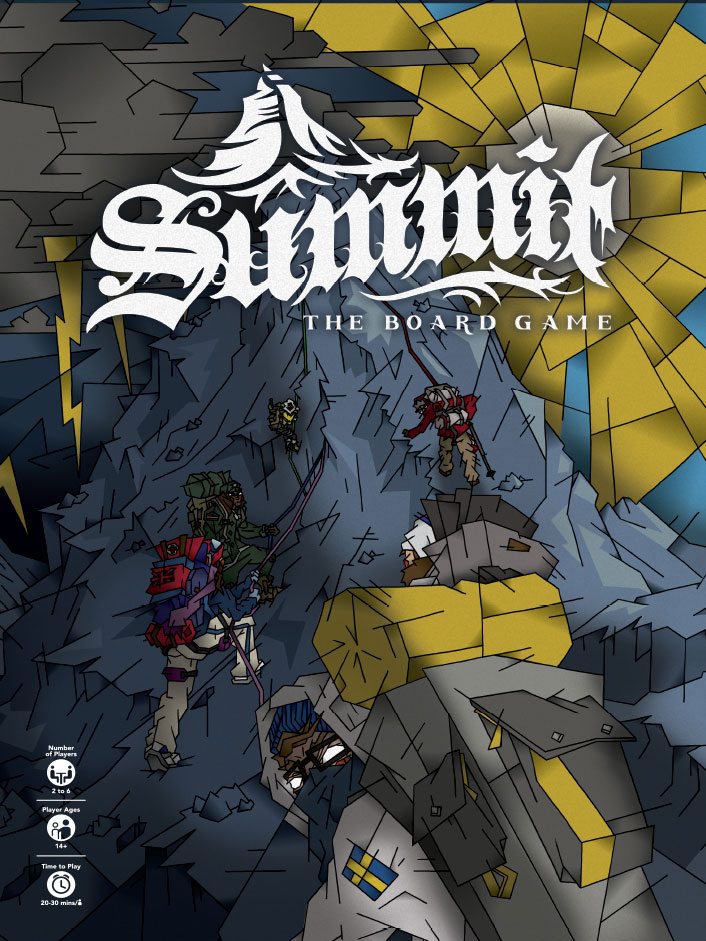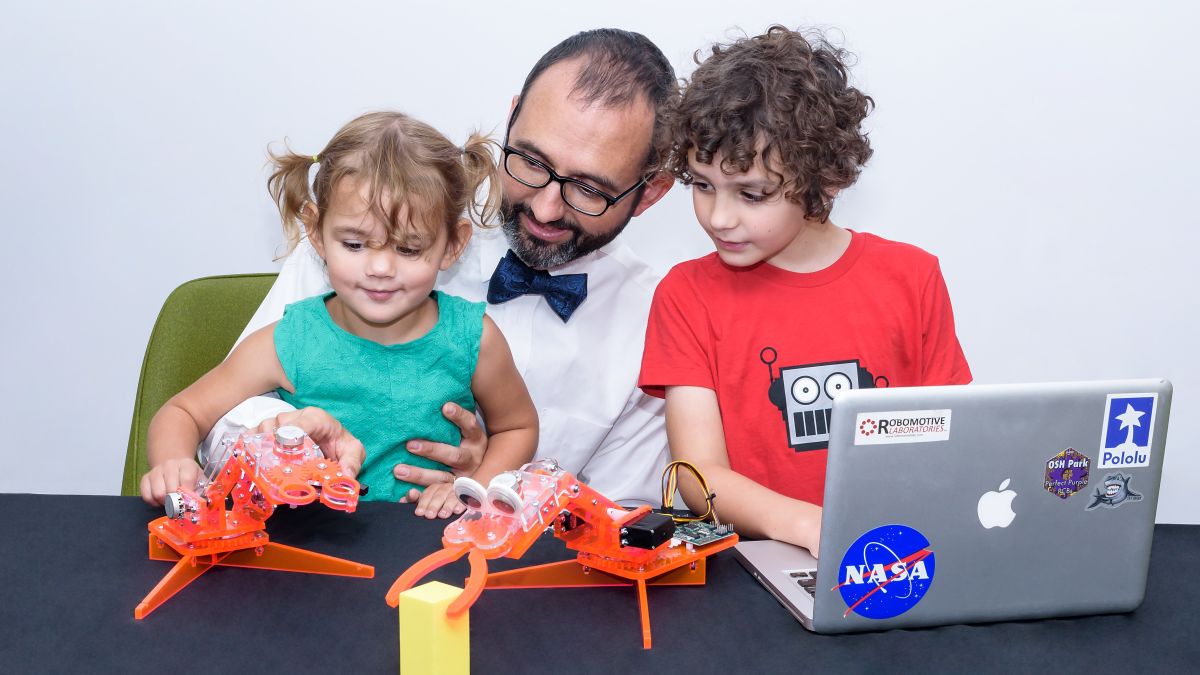Summit is a race to the top of the mountain and back down to base camp, but you must manage your food, oxygen, and gear carefully or you might not survive the trip. Help out your fellow climbers or interfere with them—either way, you’ll earn karma that’ll come back around.
At a glance: Summit is a mountain-climbing game for 2 to 6 players, ages 14 and up, and takes roughly 20–30 minutes per player. It’s currently seeking funding on Kickstarter, with a pledge level of $49CAD (roughly $37USD) for a copy of the game. There is an optional cooperative/solo mode expansion also available through this campaign, for $15CAD more. The competitive mode can be quite aggressive (depending on the players) so keep that in mind when playing with kids or less-experienced gamers.
New to Kickstarter? Read our crowdfunding primer.

Components
- 1 Game board
- 1 Sherpa board
- 1 Time board
- 1 Blizzard Marker
- 1 Active Player Token
- 2 Dice (1 Weather Die, 1 Event Die)
- 6 Player Mats
- 6 Pawns (1 per player color)
- 60 Marker Cubes (10 per player color)
- 48 Tokens (10 Oxygen, 10 Numbered Item, 28 Event)
- 90 Tiles:
- 2 Base
- 2 Halfway
- 2 Summit
- 28 Standard
- 28 Ice
- 28 Thin Air
- 165 Cards:
- 63 Karma
- 31 Item
- 65 Events

Cooperative/Solo Expansion
- 1 Time of Day track
- 1 Time of Day marker
- 1 Sherpa track
- 21 cards (1 Item, 20 Events)
I played a prototype of the game so components were not final quality, and some elements may be subject to change.
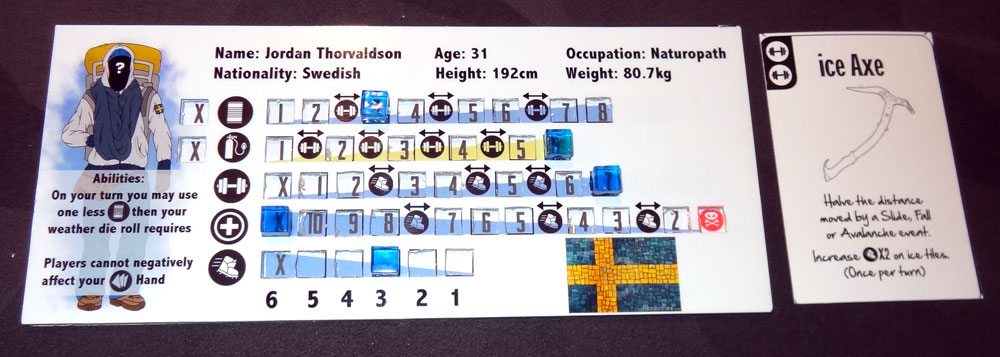
Each player mat has a different character on it, with a special ability and its own stats. The player mats were double-layered, with holes cut in the top layer so that the marker cubes could be set into it. There are five rows: food, oxygen, weight, health, and speed. As you increase food and oxygen, you pass over some “weight” symbols. Each weight symbol you pass increases your weight by 1. And then on the weight and health tracks, you pass over “speed” symbols—each one you pass (by carrying more weight or losing more health) decreases your speed.
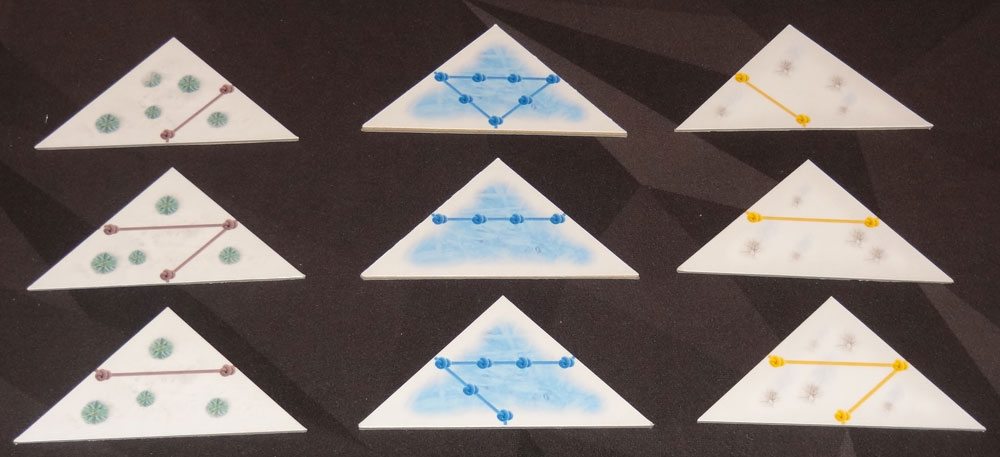
Most of the tiles are triangular (a half-square), with the exception of the Summit and the Halfway tiles (which are full squares). They have patterns of ropes with knots, indicating how you can move along a path up and down the mountain. Brown ropes are normal tiles, blue ropes are ice tiles (and have more knots so that it takes more movement points to cross them), and yellow ropes are thin air tiles (which require oxygen when you enter them). When placing them, you have to match up long sides to long sides and short sides to short sides. I did find myself wondering about what the game would be like with equilateral triangles, simply because then the overall board would be hex-based and tiles could be rotated—but the right triangles actually do provide for some important limitations that force you to go in certain directions.
The board is a large image of a mountain with gridlines laid out on it, and spaces marked for base camp and halfway camps depending on the difficulty level. There’s also a karma track on the right, a blizzard track on the left, and some scoring tracks on the left.
There are a lot of components in this game; not everything is used in every game—some components are for the cooperative game only, some are used depending on number of players, and so on. The artwork is not complete, so I can’t really comment on that as much.
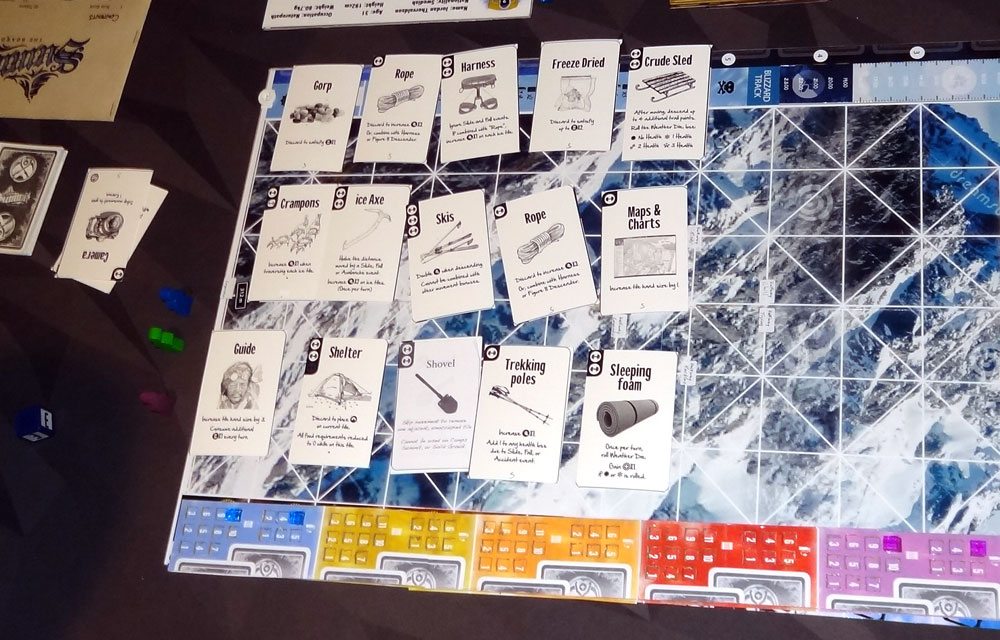
How to Play
You can download a rulebook PDF here.
The goal of the game is to score the most points by reaching the halfway camp, summit, and base camp. You also score points based on your karma. (The cooperative variant will be explained later.)
To begin, set up the board by placing base camp, halfway camp, and summit files: the harder the difficulty level, the bigger the mountain will be. (With more players, there will be 2 base camps, and you can make the game easier by using 2 halfway camps as well.) Place the blizzard marker at the level on the Blizzard track corresponding to the chosen difficulty level.
Each player gets a player board, the pieces of their color, 4 Karma cards, and 3 tiles. Lay out 3 times as many Item cards as players—players will get a chance to choose up to 2 gear cards from these, and the rest are shuffled back into the deck. Some gear has weight icons on it—if you keep gear, you must increase your weight level by the number of icons. You may also decide how much food and oxygen you would like to take, increasing your weight and decreasing your speed accordingly. Once everyone has geared up, you’re ready to start at base camp.
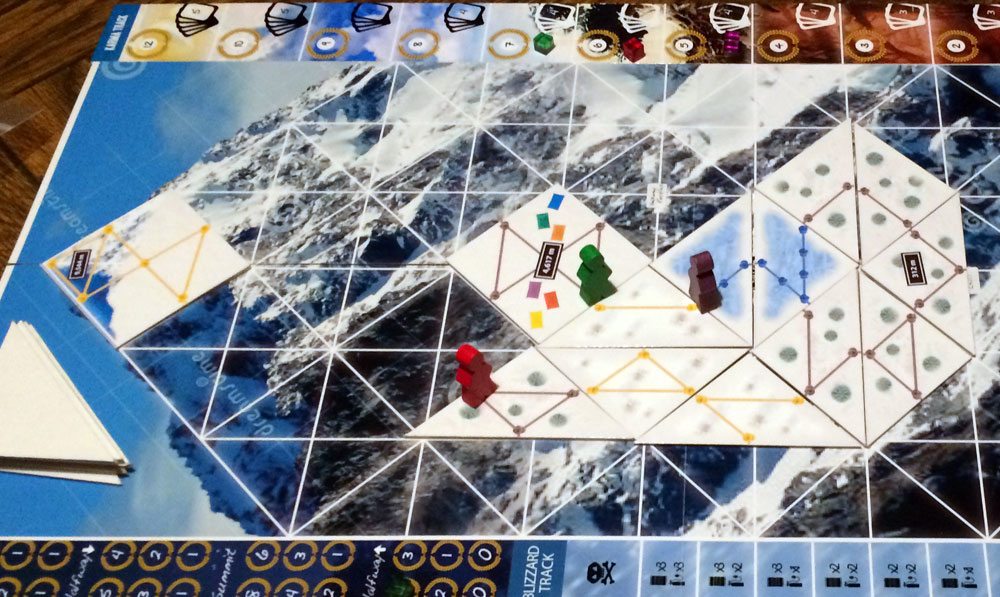
(Prototype shown) Photo: Jonathan H. Liu
On your turn, you may move up to your current speed; you travel along the “knots” on the tiles, and add new tiles from your hand as needed. Or, you can sacrifice your movement for another option: refresh your hand of tiles, attempt to remove a negative token or card from your character, or resupply and heal if you’re at camp.
At the end of your turn, you must roll and resolve the Event die and the Weather die. The Event die has a 2/3 chance of an event—you draw the top card and do what it says. Some events are good: you found some supplies! (No doubt left behind by an unsuccessful climber.) And some events are bad: avalanches, altitude sickness, blizzards… Okay, so a lot of events are bad. The Weather die will determine how much food you need to use—and if you roll the blizzard icon, then you move the marker up the Blizzard track and everyone has to use some food (and eventually oxygen). The higher the Blizzard track, the worse it gets—and if you reach the top of the Blizzard track, everyone dies.

The Karma cards can help or hinder other players, and will move you up or down the Karma track, which will be worth points at the end of the game. You can also earn or lose Karma when a player wants to get past you. In order for another player to move past you, they must ask permission first. If you grant it, you get 1 Karma; deny it, and you lose 2 Karma but the player must stop or find an alternate route.
There are scoring tracks to indicate the order in which players reach the halfway camp (on the way up), the summit, the halfway camp (on the way down), and base camp. The earlier you arrive, the more points it’s worth. You must reach the summit and get back down to base camp, but stopping at the halfway camp is optional. On the other hand, halfway camp is a chance to restock on food and oxygen, as well as pick up more Items, so it’s usually a good idea.
As you consume food and oxygen and use equipment, your weight may decrease, which then increases your speed. However, if you need food or oxygen and you’ve run out, you take wounds instead—which will slow you down. Lose your last bit of health, and you have succumbed to the mountain.
The game ends as soon as all players have made it back down to base camp or have died. Add up all the scores from reaching the checkpoints and from the Karma track. Highest score wins.
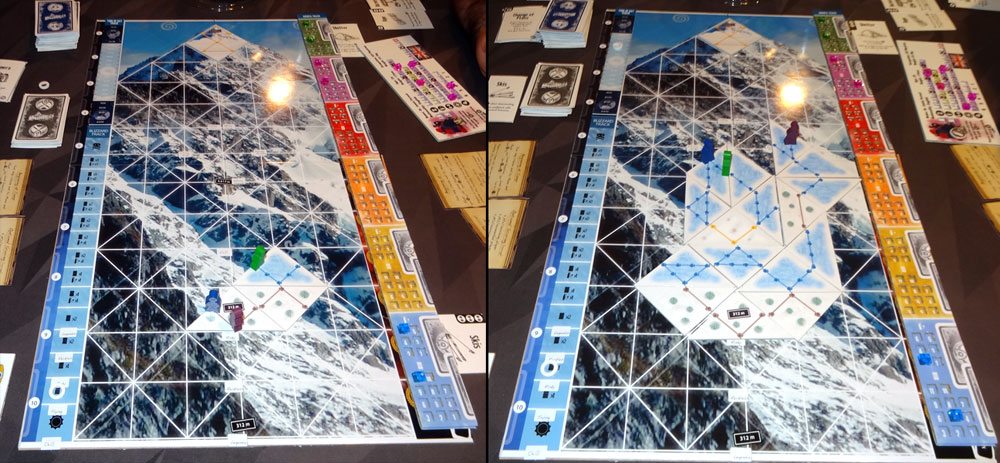
Cooperative Mode
I won’t get into all the details, but the cooperative mode lets you work together to summit and return. At least one player must make it to the summit and back, but you get more points if more players reach the top. In addition to the regular set up, each player also has a sherpa, who can carry additional food, oxygen, and equipment. They’ll consume food and oxygen during blizzards, but not otherwise, and they can carry any amount without affecting your character’s weight. However, you have to spend a turn not moving in order to exchange things with your sherpa, and you cannot use anything unless you’re carrying it. You also don’t use a halfway camp—it’s just straight to the top and down again.
The Karma cards are not used. In addition, there are some cooperative Event cards that are added in, and some of the competitive Event cards are removed.
The scoring tracks are replaced with a Time of Day track—you decide as a team what time to start, and after each round of play, the time moves forward an hour. During the night, your movement is halved.
You score points at the end for each player that survived, each player that summited, each surviving sherpa, and each point of health left among the players. You also earn points if you finished in less than 24 hours.

The Verdict
I’ve gotten to play Summit in both competitive and cooperative modes, and it was fun, but pretty brutal—particularly the competitive mode. It’s not perfect, but I’ve talked with designer Conor McGoey and he has been continuing to do a lot of playtests and making tweaks even leading up to the Kickstarter campaign.
The cooperative mode is an expansion, but I think it’s actually a nice way to start: you learn the ropes, so to speak, without having to worry about other players actively interfering with you. The mountain is hard enough, really. The very first round, I drew the “Overloaded” Event card: the fullest sherpa (mine) was removed from the game along with all supplies. I did eventually get a sherpa back, thanks to the “Search Party” Event card, but he came back with only 5 food and 2 oxygen rather than the full load I’d started with. Also, our party of three got separated early on—one player took a branching path that just never managed to join up until the summit, which meant that we weren’t able to trade equipment or help each other out as much. Still, all three of us made it back down the mountain (the last one was a bit iffy) but we didn’t get any bonuses for finishing quickly.

One competitive game I played was incredibly cutthroat, and ended up with one casualty—me. But it seems we also had the perfect storm of poorly timed events. One event flipped over two of the tiles right near the summit after the other players had reached the top but before I got there, preventing my passage. We all had to take a longer path (for me to ascend and for them to descend), and in the meantime a disaster struck and our halfway camp was destroyed—no more restocking supplies on the way down! (This was one of the “Black Diamond” events that’s optional to include.) But on top of that, all three of us denied permission to pass several times, which wasted valuable time and resources. In the end, I ran out of food and oxygen and couldn’t make it all the way back down. I’d chosen to keep some equipment that could help me with particular incidents and cross icy tiles more quickly, but the weight slowed me down too much. The other two players did make it back down the mountain, but it was a little iffy for a while.

Another competitive game I played (with a mix of kids and adults) was a little less harsh. There were some shenanigans and some negative Karma cards played, but there wasn’t a lot of blocking passage. One funny thing was the use of the Grappling Hook to place tiles on top of other tiles—I could redirect a path after you climb past it, leaving those behind me to fend for themselves. But then another player stole the Grappling Hook from me, which meant I couldn’t rebuild those paths myself on the way back down.
I think my favorite part of the game is the balance between speed and safety. The more food and oxygen and gear you have, the safer you are—but you can only carry so much weight, and if you are fully loaded up, you’re barely moving. If you travel light, you can move up to 6 spaces per turn (7, if you’re using the Jamaican climber) but if you run into unexpected circumstances, you’ll start losing health. Likewise, you can make the decision about whether to skip halfway camp and push on to the summit: it might be worth it if you’re late to the halfway camp and will score better by being first to summit, but it means you won’t get a chance to stock up until you come back down. There are some cards that will let you really play with the risks, too: for instance, the Wingsuit equipment can be used to descend to any camp below you instantly—but you roll the weather die, and if you roll a “blizzard,” you’re out of the game.

The Karma track is an interesting way to track whether you’re being nice or mean—it does mean you have opportunities to block or attack other players, but it costs you points. How many points is it worth to prevent this player from passing you right now? Is it worth helping this player out with some extra food for a couple of Karma points? And, of course, if you’re at the bottom of the Karma track, you can’t block players anymore because it would cost you karma that you don’t have.

I’ve really enjoyed playing Summit, even when losing. It’s a game that allows for some really great moments (both good and bad), and I like that there are different approaches to victory. There’s definitely a lot of luck involved—some events are good and some are bad, sometimes you’ll have a sunny day and sometimes you’ll have a blizzard—so it may not be quite as appealing to somebody looking for something that is more strategic and skill-based. However, you do get to make a lot of decisions on which things you want to risk, and that’s one of the things I love about it.
For more information about Summit, visit the Kickstarter page.
Disclosure: I was provided with a demo prototype for this review.
Save
Save

